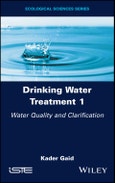Today, hundreds of millions of people drink contaminated water without knowing it. Yet water treatment technologies can effectively eliminate contamination and can supply urban and rural populations with safe drinking water in a secure way.
For almost two centuries, the huge number of treatments available to guarantee water quality has grown alongside technological progress, the strengthening of industry norms and the reinforcement of consumer expectations. New treatment methods have been developed according to the advancement of knowledge and new sanitary regulations.
This five-volume book sets out to clearly present the variety of treatments available along with their performance, limitations and conditions of use as well as ways to combine them to produce safe drinking water, which is a basic need essential to everyday life.
The author shares his expertise acquired at Veolia, a company that is a world leader in water services and sanitation, desalination of sea water and the recycling of wastewater. Founded in France in 1853 to bring safe water to populations and to protect them from waterborne epidemics which ravaged cities, its history is intertwined with that of water treatment.
Table of Contents
Chapter 1 Introduction 1
Chapter 2 Physicochemical and Microbiological Composition of Raw Water 9
2.1 Water resources 9
2.1.1 Physicochemical parameters 10
2.1.2 Algae (including cyanobacteria and cyanotoxins) 18
2.1.3 Tastes and odors 22
2.1.4 Micropollutants 24
2.2 Microbiology 28
2.2.1 Bacteria 29
2.2.2 Viruses 30
2.2.3 Parasites (Cryptosporidium and Giardia) 32
2.3 Quality of water intended for human consumption 34
2.3.1 Microbiological parameters 35
2.4 References 42
Chapter 3 Aeration and Stripping 43
3.1 Cascade aeration 43
3.1.1 Characteristics 44
3.2 Operating principle of a cascade aerator system 45
3.2.1 Data 49
3.2.2 Goals 49
3.2.3 Results 49
3.3 Aeration by fine bubble diffusers 51
3.3.1 Air diffusers 52
3.3.2 Air insufflation by oxytube 52
3.4 Stripping 53
3.4.1 Stripping tower design 54
3.4.2 Description 58
3.4.3 CO 2 removal 60
3.4.4 Tetrachlorethylene and trichlorethylene removal 61
3.5 Synthesis of aeration systems 61
3.6 References 62
Chapter 4 Coagulation-flocculation 63
4.1 Colloidal matter 63
4.2 Coagulation 65
4.2.1 Double-layer compression 70
4.2.2 Adsorption and interparticle bridging (flocculation) 71
4.3 Flocculation 74
4.3.1 Perikinetic flocculation 74
4.3.2 Orthokinetic flocculation 76
4.3.3 The influence of agitation 79
4.3.4 G and t 81
4.4 Coagulants 85
4.4.1 Metallic coagulants 85
4.4.2 Synthetic organic coagulants 97
4.5 Flocculants 99
4.5.1 Natural organic and synthetic flocculants 99
4.5.2 Flocculation adjuvants 105
4.6 Factors affecting coagulation and flocculation 105
4.6.1 Influence of water temperature 105
4.6.2 Influence of pH 106
4.6.3 Coagulation and flocculation times 111
4.7 How to choose the best coagulant? 111
4.7.1 How to choose the optimal dose of coagulant? 113
4.8 Residual aluminum 115
4.9 Alkalinity consumption 116
4.9.1 Aluminum and alkalinity 117
4.9.2 Iron and alkalinity 120
4.10 Reduction efficiency of some water constituents 125
4.10.1 Turbidity and SS 125
4.10.2 Microorganism removal 128
4.11 Jar tests 130
4.11.1 The specific case of jar test for Actiflo ® 134
4.12 References 138
Chapter 5 Settling 143
5.1 The principles of settling 143
5.2 Horizontal settlers 145
5.2.1 Principle 145
5.2.2 Design 149
5.2.3 Implementation 150
5.3 Lamella settlers 152
5.3.1 Theory and principle 153
5.3.2 Basic design for lamella settlers 156
5.3.3 Implementation 162
5.4 Veolia technologies 165
5.4.1 Lamella settlers: Multiflo ® settler 165
5.4.2 Ballasted floc settlers 176
5.5 References 198
Chapter 6 Flotation 203
6.1 The scope of DAF 204
6.2 The main stages of a flotation process 205
6.2.1 Coagulation 205
6.2.2 Flocculation 206
6.2.3 Flotation 206
6.3 The fundamental mechanisms of flotation 207
6.3.1 Coagulation 209
6.3.2 Flocculation 209
6.3.3 Contact zone 210
6.3.4 Separation zone 228
6.4 Design parameters 232
6.4.1 Coagulation 233
6.4.2 Flocculation 233
6.4.3 Flotation zone 234
6.4.4 Contact time 239
6.4.5 Temperature 239
6.4.6 Air saturation tank 239
6.4.7 Mass balance 243
6.4.8 Recirculation and injection nozzles 244
6.5 Operating parameters affecting flotation performance 245
6.5.1 Choice of coagulant 245
6.5.2 Rise velocity 248
6.5.3 Contact time 248
6.5.4 Bubble volume concentration 248
6.5.5 Gas solubility 249
6.5.6 Hydraulic efficiency 249
6.5.7 Air/water ratio 249
6.6 Performance and monitoring 250
6.6.1 Treatment monitoring 250
6.6.2 Performance of DAF systems in relation to algae removal 252
6.6.3 Performance against parasites 253
6.6.4 Performance with the addition of PAC 253
6.7 Veolia technologies using flotation 254
6.7.1 Spidflow ® : principle 254
6.7.2 Advantages and limitations of DAF systems 271
6.7.3 Spidflow ® filter 273
6.7.4 Ozoflot ® 279
6.7.5 Flottazone ® 282
6.7.6 Packaged solutions: Spidflow ® Pack 284
6.8 References 287
Index 293
Summaries of other volumes 295








